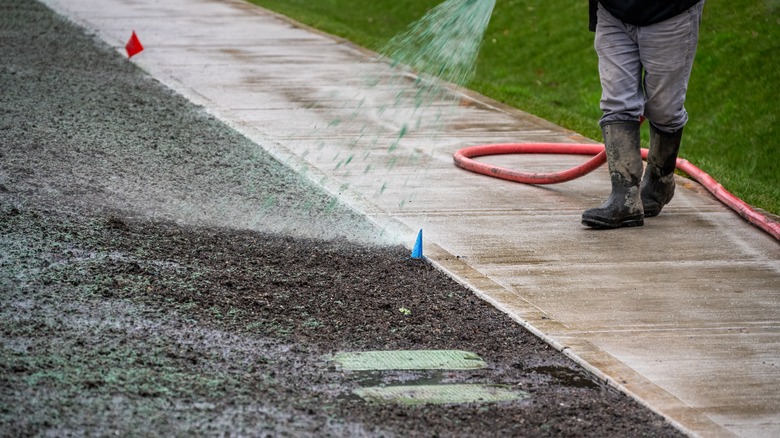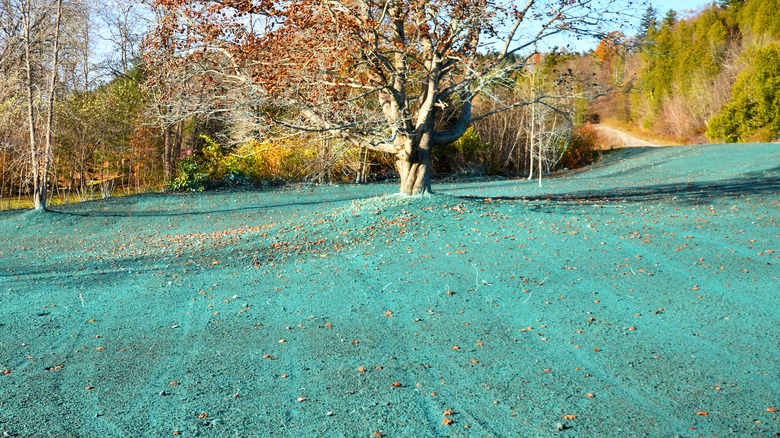TikTok's Step-By-Step Guide To DIY Hydroseeding
A lush green lawn is the pride of some homeowners and the envy of their less green-thumbed neighbors. Sometimes, to earn the title of neighborhood lawn champion, you have to start over — whether you moved into a new house with a neglected yard or a nasty drought killed your grass. Hydroseeding, where you use a high-powered hose to spray a slurry of grass seeds onto bare soil, is one of the fastest ways to revive a lawn. Choose your preferred grass species, test your soil to see what it's lacking, and prepare your property for spraying. Source and fill a hydroseeder (the hose that sprays the grass seed). Then you're ready to spray your seed slurry.
How much will it cost to hydroseed your lawn, you ask? What you'll need to budget for starts with how much seed you'll need to cover your yard adequately. Any lawn grass seed mix, including wildflower or native grass mixes, will work well in a hydroseeding slurry. Ideally, the mixture will include up to 10% fast-sprouting rye seed. Consider, too, your local climate and specific property conditions. If you live in an area prone to drought, try a low-maintenance, water-wise option. You can get 5 pounds of the California native grass seed mixture by Stover Seed for $106.50 with free delivery. Do trees overhang your yard? Invest in mixes containing shade-tolerant grasses, like the New England Semi-Shade Grass and Forbs Mix from New England Wetland Plants for $91.00 per bulk pound.
Get scientific with your soil
Before you begin, you'll need a hydrospray mulch — you'll mix this with your seed and water to make the slurry. You can get a 50-pound bag of Second Nature paper fiber hydroseeding mulch for $26.68 from Justin Seed Co. Measure the area you plan to plant in square feet to work out the volumes of seed and hydrospray mulch you need to buy. Now, It's time to test your soil! Like all plants, grasses thrive on the right balance of macronutrients (phosphorous, nitrogen, and potassium), an enormous range of micronutrients, and pH (acid or alkaline) ranges. Soil testing helps you determine the health of the ground under your lawn and what you may need to add or amend.
The process has been made surprisingly easy thanks to sophisticated DIY kits that are available for purchase online. If you have a considerable property or multiple lawns, get a large soil test kit — run up to three tests at a time — for $104.95 from Harris Seeds. On a budget? Walmart sells the highly-rated MySoil test kit for $29.99. While these kits work similarly, it's best to follow the instructions provided by the manufacturer to ensure you get reliable results. Once your soil test is done, it's time to prepare your lawn for spraying.
Clear, amend, and spray
Hydroseeding works best on bare soil. To succeed in your hydroseeding efforts, first clear the planting area of rocks, branches, trash, and weeds, properly grade your yard to protect your foundation from water damage, and dress the soil with additives (as determined by your soil test) — you can also add compost and topsoil at this stage. If you have an irrigation system, mark the sprinklers with flags so they're easy to spot when spraying. All that's left to do now is re-grade and level your lawn and get your hands on a hydroseeder.
It is most cost-effective to rent a hydroseeder from your local hardware store or, if you're handy, DIY one using a tank, hose, and electric pump. After all, how often do you need to start a lawn from scratch? What size tank you need depends on your lawn size. For example, Turbo Turf's smallest hydroseeder, a 50-gallon tank unit for $2,295.00, will seed 650 square feet of lawn per load. Most machines allow you to mix the hydroseed slurry right in the tank. Add water (at a ratio of 1:20 mulch to water), your mulch, the seed, and any other additives, like eco-friendly dyes (typically green, so you can see where you've applied it), binder, and lawn fertilizer. If in doubt, refer to the manufacturer's instructions on the machine or mulch bag. Then you can start spraying. When you're done, brush up on how to care for your lawn after hydroseeding.

